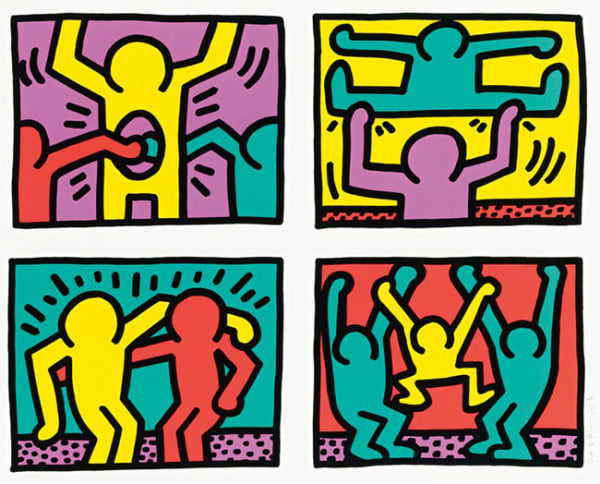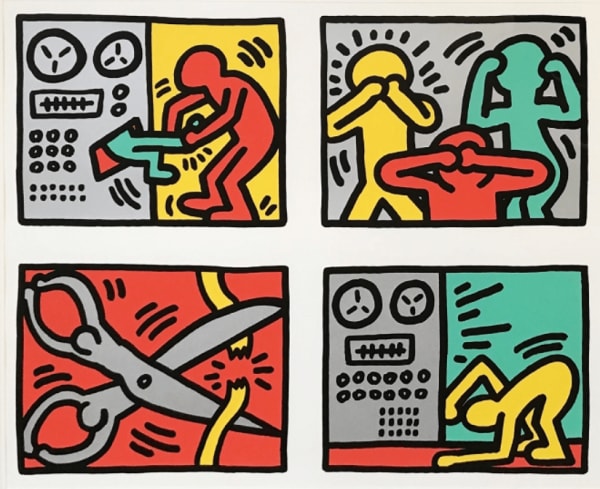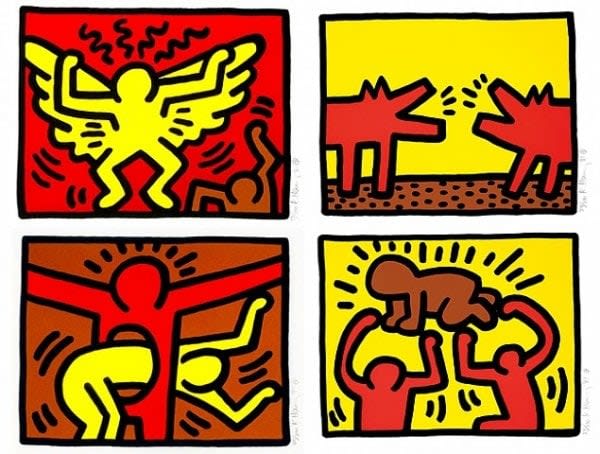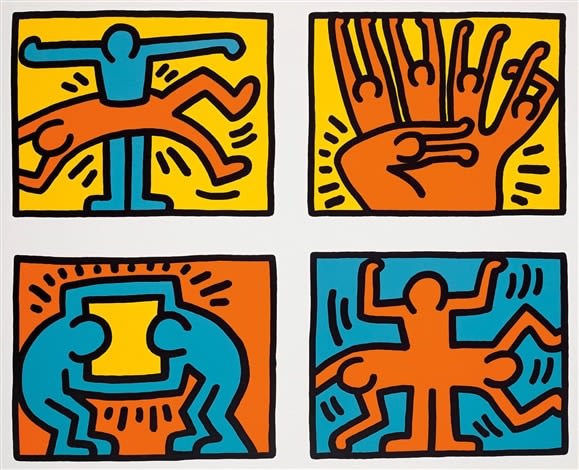Keith Haring's Pop Shop Quads form an integral part of his vibrant artistic legacy, reflecting his belief in the accessibility of art and his commitment to spreading his iconic visual language. Created in a series, each quad features four panels, bringing together symbols and figures from Haring’s body of work. His recognizable characters—such as the Radiant Baby, Barking Dog, and dancing figures—are placed together in energetic compositions that embody themes of joy, activism, and human connection. Through the Pop Shop Quads, Haring emphasizes art’s role in both reflecting and challenging societal norms, making his imagery accessible to a wide audience.

The first of the series, Pop Shop Quad I (1987), sets the stage for the rest by presenting Haring’s familiar characters in a dynamic and playful arrangement. The four panels are filled with vibrant human figures and animals, each rendered in bold lines and bright colors. These figures engage in lively movements, reflecting Haring’s emphasis on freedom of expression and the vitality of life. The joyful dance of human figures, highlights individual freedom from societal constraints. The minimal, flat backgrounds serve to amplify the energy of the characters in each panel, making the work visually captivating and conceptually rich.
Pop Shop Quad II (1988) builds on the foundation of the first quad, intensifying the action between characters and introducing new symbolic elements. One notable figure in this quad is the angel, a recurring character in Haring’s work that symbolizes hope and protection. The angel’s interactions with other figures suggest a theme of compassion, with the characters collectively embodying Haring’s belief in unity and cooperation. This quad emphasizes movement and connection, with the figures forming a narrative of mutual support, underscored by Haring’s minimal yet powerful use of color and space. The figures’ exaggerated movements and interactions remind viewers of the importance of solidarity and shared humanity.
Pop Shop Quad III (1989) takes a slightly different turn, introducing new characters and exploring themes of love, resistance, and the juxtaposition of innocence and aggression. The Radiant Baby, one of Haring’s most iconic symbols, is central to this quad, radiating lines of light that convey purity and divine energy. The baby figure contrasts sharply with the more menacing characters that populate the other panels, creating a dynamic tension that invites viewers to consider the dualities of good and evil, innocence and corruption. The simplicity of the forms belies the deeper themes at play, with Haring using his signature iconography to critique power structures and highlight the ongoing struggle for justice and peace.

Pop Shop Quad IV(1990) stands out for its intensity, using a more aggressive color palette and densely packed figures to convey heightened emotional impact. This quad delves deeper into the critique of authority that is a constant theme in Haring’s work, with the figures appearing to struggle against invisible forces. One panel features a figure clutching a heart, a symbol often associated with love and vulnerability in Haring’s work. The tension between love and power is emphasized through the use of vibrant reds and blacks, creating a visually and emotionally charged composition that speaks to the complexities of human relationships and societal structures.
Pop Shop Quad V (1990) takes a more optimistic turn, focusing on themes of collaboration, solidarity, and celebration. The figures in this quad are engaged in dance, their exaggerated movements and joyful poses reflecting Haring’s enduring belief in the power of unity and collective action. The bright yellow and green backgrounds set a tone of positivity, aligning with Haring’s vision of art as a means of uplifting and inspiring individuals and communities. Despite its playful appearance, this quad continues to explore deeper social themes, subtly conveying the importance of resistance and resilience in the face of societal pressures through the symbolic dance of the characters.
Pop Shop Quad VI (1990) marks a shift toward abstraction, as Haring simplifies his figures into geometric forms while retaining their expressive energy. The characters in this quad remain instantly recognizable, reflecting Haring’s ability to distill complex emotions and ideas into minimalist designs. The quad’s reduced imagery highlights Haring’s belief that art should be approachable and appreciated by all, breaking down barriers between high art and popular culture. The vibrant colors and simplified forms create a dynamic visual dialogue that invites viewers to engage with the work on multiple levels, whether as a celebration of aesthetic beauty or as a commentary on social issues.
Through Pop Shop Quads I–VI, Keith Haring masterfully conveys his signature themes of love, resistance, and unity, using simple forms and bold colors to explore complex societal issues. The quads are a testament to his belief in art as a powerful medium for communication and change, accessible to everyone regardless of background or artistic knowledge. Each quad brings something new to the series while maintaining a cohesive visual language that resonates with Haring’s broader body of work, making the Pop Shop Quads a significant chapter in his artistic legacy.
Discover Keith Haring original prints at Guy Hepner and contact our team via info@guyhepner.com. Thinking of selling? We can help! Find out how to sell Keith Haring prints with our galleries.







